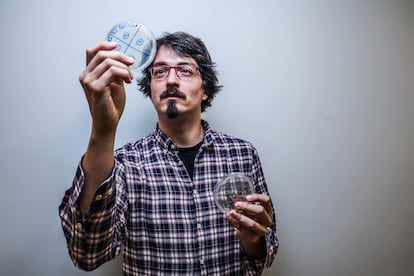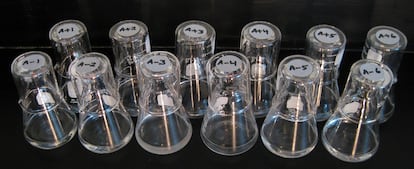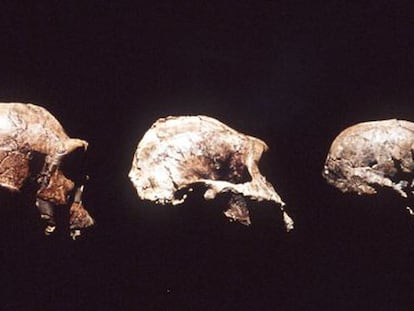A legendary experiment that began in 1988 suggests that evolution is predictable
The patience of a scientist, who has cultivated 75,000 generations of bacteria for 35 years, has paved the way for the discovery that it is possible to anticipate transformations in living beings

Fanatics convinced that a god created the world as it is — the so-called creationists — have viciously attacked Richard Lenski. In 1988, this American biologist began one of the most daring experiments in history. He began to cultivate 12 populations of identical bacteria in independent containers, to observe their evolution firsthand. The project was to last a few months, but its results were so striking that Lenski’s team from Michigan State University has been overseeing these microbes every day for more than 35 years. There are about 75,000 generations — the equivalent of seeing the human lineage transform over more than a million and a half years. Spanish biologist Alejandro Couce, 42, and his colleagues have now immersed themselves in Lenski’s microworld and have reached an extraordinary conclusion: “Evolution can be predictable in the short term.”
Couce, born in the Spanish town of Irixoa, cites a famous thought experiment proposed by paleontologist Stephen Jay Gould in his 1989 book Wonderful Life. If you could rewind the Earth back hundreds of millions of years and start again, would the same thing happen? Would intelligent bipedal beings capable of writing Don Quixote emerge again? Would giraffes and butterflies appear? Gould’s big question was whether evolution depends on chance or whether it is determined.
Lenski has produced a massive amount of work since 1988. The bacteria under investigation is Escherichia coli, which is present in human intestines. Almost seven generations live in a single day. Scientists have to change their culture medium every day, whether it is a public holiday, weekend or in the middle of the summer vacations. The 12 populations have lived all this time on water, salts and glucose, but the result is surprisingly different in the 12 containers. In the 31,500th generation, one of the colonies learned to feed on sodium citrate, one of the ingredients of its culture medium, which this type of bacteria had previously rejected. A new, de facto species appeared, but only in one of the 12 populations.
Lenski has patiently stored frozen samples of his bacteria every 500 generations. In his freezers, it is possible to explore what has happened since 1988, and address an even more ambitious — and almost philosophical — question: could it all have happened differently? Couce, from the Polytechnic University of Madrid, explains that his team asked Lenski for microbes from different generations. Their goal was to thaw the microbes, multiply them and test hundreds of thousands of mutations to analyze how each of them was affected.

“If you go back 75,000 human generations to 1.5 million years ago, Homo sapiens did not yet exist. What we have done is like taking a Homo erectus, making all the possible mutations to all of its genes and asking yourself if those mutations are going to give rise to a Neanderthal, the Homo antecessor of Atapuerca or Homo sapiens,” says Couce. His team, he says, has been able to predict “up to 75% of the first adaptive steps” of bacteria. Their results were published on Thursday in the prestigious journal Science.
However, Lenski, a co-author of the new study, is cautious. His experiment has maintained the same, fully controlled conditions since 1988, day after day, which is very different from what happens on planet Earth, subject to climate change, meteorites, solar flares and endless interactions between living beings. “I am excited by these new results, but science is still far from being able to predict evolution in the vast and complex natural world. In any case, that’s how science usually works: advancing gradually, not solving everything at once,” says Lenski, who was involved in the investigation of the anthrax attacks following the September 11, 2001, attacks in the United States.
Gould's enigma will probably never be answered. “These new data, as well as other findings from the experiment I began in 1988, show that, even under these simple conditions, evolution produces a rich and fascinating mix of the predictable and the unpredictable. I suspect that the same thing happens when evolution is expanded to the large planetary scale that Gould was thinking about,” explains Lenski.

Couce says that his team applied the new massive genetic engineering techniques to the so-called Long-Term Evolution Experiment. The Spanish biologist believes that the results allow him to “dream” of making concrete predictions about the evolution of pathogens and pests, as science can already do with the climate. “This work opens the door to predicting what is important for a new virus to jump from the pangolin and adapt to humans,” he says.
Microbiologist Sara Hernando Amado praises the “brilliant idea” of Couce and his colleagues. “Not only do they raise one of the most interesting questions that can be asked in biology — whether it is possible to predict evolution — but they also lead us to a question that is key to solving one of the greatest health challenges we face: is it possible to predict the emergence of antibiotic resistance in pathogenic bacteria?” says Hernando Amado, a researcher from Spain’s National Center for Biotechnology, in Madrid. “We have a tool — evolutionary knowledge — that can allow us to stop or slow down the emergence of resistance associated with the use of antibiotics, simply by choosing them better,” she adds.
Microbiologist Jerónimo Rodríguez Beltrán also applauds the new study, in which he did not participate. “It shows that, at least in the laboratory, evolution is to some extent predictable. As long as conditions remain constant, the tape of life would play the same song. At least the first chords,” says the researcher, from the Ramón y Cajal Institute for Health Research, in Madrid. “It is a tremendously important discovery, because it opens the door to predicting bacterial evolution, which has applications in fields as diverse as biotechnology, where bacteria are used to produce compounds of interest, or medicine, in which bacteria resistant to antibiotics are becoming alarmingly prevalent,” he adds.
A report by the British government warned in 2016 that drug-resistant microbes — especially bacteria — were killing 700,000 people globally every year. According to the document, antimicrobial resistance could kill 10 million people a year by 2050, a higher figure than cancer. Rodríguez Beltrán points out that the new data are only valid for bacteria that do not exchange genetic material with each other, a very common phenomenon in other microbes, which is behind the spread of antibiotic resistance. The microbiologist, however, is optimistic: “The results of this work are a boost to scientists who are trying to predict the emergence of multiresistant bacteria: they tell us that it is possible. That there is light at the end of the tunnel.”
Sign up for our weekly newsletter to get more English-language news coverage from EL PAÍS USA Edition
Tu suscripción se está usando en otro dispositivo
¿Quieres añadir otro usuario a tu suscripción?
Si continúas leyendo en este dispositivo, no se podrá leer en el otro.
FlechaTu suscripción se está usando en otro dispositivo y solo puedes acceder a EL PAÍS desde un dispositivo a la vez.
Si quieres compartir tu cuenta, cambia tu suscripción a la modalidad Premium, así podrás añadir otro usuario. Cada uno accederá con su propia cuenta de email, lo que os permitirá personalizar vuestra experiencia en EL PAÍS.
¿Tienes una suscripción de empresa? Accede aquí para contratar más cuentas.
En el caso de no saber quién está usando tu cuenta, te recomendamos cambiar tu contraseña aquí.
Si decides continuar compartiendo tu cuenta, este mensaje se mostrará en tu dispositivo y en el de la otra persona que está usando tu cuenta de forma indefinida, afectando a tu experiencia de lectura. Puedes consultar aquí los términos y condiciones de la suscripción digital.
More information

Evolution on a grand scale: how, 50 million years ago, the ‘thunder beast’ went from weighing 20 kilos to five tons

How prehistoric DNA is helping to unlock the secrets of human evolution
Archived In
Últimas noticias
NASA discovers Titan doesn’t have an ocean, but a ‘slushy ice layer’ that increases possibility of life
Innocence lost in the forest of the child soldiers: ‘Each leader of the armed group had his girls’
‘Fallout’ or how the world’s largest company turned an anti-capitalist apocalyptic Western into a phenomenon
From inflation to defending migrants: Eileen Higgins and Zohran Mamdani inaugurate the new Democratic resistance against Trump
Most viewed
- Christian Louboutin: ‘Young people don’t want to be like their parents. And if their parents wear sneakers, they’re going to look for something else’
- ‘El Limones’ and the growing union disguise of Mexican organized crime
- The low-cost creative revolution: How technology is making art accessible to everyone
- ‘We are dying’: Cuba sinks into a health crisis amid medicine shortages and misdiagnosis
- Liset Menéndez de la Prida, neuroscientist: ‘It’s not normal to constantly seek pleasure; it’s important to be bored, to be calm’









































